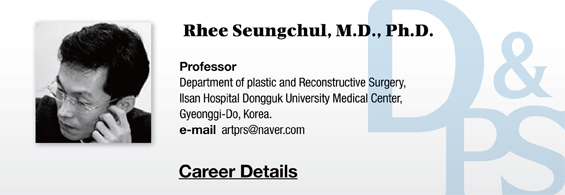
Equal Third Theory
‘The face is divided into equal horizontal thirds’.
In the equal third theory, a traditional theory on facial aesthetics, an attractive face is horizontally divided into three equal parts from trigion to glabella, glabella to subnasale, and subnasale to menton. This theory posits that the three horizontal divisions of the face should have the ratio of 1: 1: 1 and was held as conventional wisdom by artists in the Renaissance period.
According to this theory, the forehead height (tr-g), nose height (g-nasion) and lower face height (sn-gn) should be the same. However, many studies and books have already debunked this theory as the equal thirds are very rare even in Caucasians. Studies involving average people found that Caucasians often have a smaller mid-face compared to upper face and a larger lower face compared to the mid-face and upper face.8

Image 2. Three quarter theory
A study conducted in 2000 found that on average, Far-East Asians have a longer mid-face than upper face, the height of the mid-face is similar to that of the lower face, and the upper face is smaller than the lower face. 9
On the other hand, an attractive Caucasian face had a ratio of 55.4: 62.7: 57.7 for upper face to mid-face to lower face. And this ratio was 60.5: 69.8: 61.8 in an Attractive Asian face. To simplify this, the ratio of upper face to mid-face to lower face in an attractive Caucasian face is close to 1: 1.1: 1 and it is 1: 1.2: 1 in an an attractive Asian face. This is not in agreement with Farkas’ study published in 1985 reporting that the proportions of three horizontal division of a Caucasian female face was 29.6%, 33.6%, and 36.7% (result 8), nor is it in agreement with the result 9 of Sim et al.
A study involving average people, reported the proportions of the three horizontal sections of the face was 30.4%, 33.5%, and 33.6%.10 This shows there is a clear proportional difference between an attractive face and an average face. It is lamentable that the equal third theory is still used in various aesthetic books and anthropometric analyses of the face.
Branched from the equal third theory, there is a belief that an attractive lower face also divides into three equal horizontal sections. I have disproved this concept as well. According to the traditional theory, the lower face can be divided into subnasale-stomion, stomion-supramentale, and supramentale-gnathion and these three sections have the ratio of 1: 1: 1. I measured the proportion of the subnasale-stomion distance against the entire lower face (sn-sto/sn-gn). I found that this proportion was 34.0% in an attractive Caucasian face and 33.7% in an attractive Asian face. This showed that the three equal theory of the lower face also did not agree with today’s aesthetic standards.
Per my findings, in an attractive face of today, the mid-face is longer than the lower face or upper face. I also found that the upper face and the lower face have similar height. Therefore, the equal third theory, as it is based on ancient art, can be useful in discussing commonness, however, it cannot be used as an aesthetic standard in aesthetic plastic surgery.
HELIOSⅡ/LOTUSⅡ/HYPERION – Manufacturer: LASEROPTEK(www.laseroptek.com)
Three quarter theory
In facial analysis, the facial width is measured as the distance between the lateral-most points of the two zygomatic arches (zy). The facial length is defined as the distance between trigion (tr) to gnathion (gn) in the frontal face. However, in ancient aesthetics, an attractive face has a ratio of 1:1.34 between the facial width and length. That is the facial width should be 2/3 or 75% of the length.8 A Korean study examined 180 average faces in 200510 found that the mean facial length and width of an average women in their 20s was 182.38mm and 134.9mm, respectively. These measurements have 1: 1.35 (74%) ratio, which is very close to the reference of the three quarter theory.
However, other Korean studies reported widely varying ratios from 1: 1.29 to 1:1.43 (Table 1).10 Yong-jin Cho reported in this 1999 study that this ratio was 1: 1.37 in Koreans, 1: 1.31 in Japanese, and 1:1.33 in Thai people. Therefore, it seems that an average face aligns with the three quarter theory where the width of the face is 75% of the length. However, these are findings from average faces and were not applicable to attractive faces. I found this ratio to be 74.4% in attractive Caucasian faces and 72% in attractive Asian faces, both showing a narrower facial width than the three quarter theory. The ratio would be approximately 1: 1.39. This is also different from the Marquardt golden mask (Image 2). Therefore, the three quarter theory should be used with caution in races other than Caucasians11.
-To be continued




















